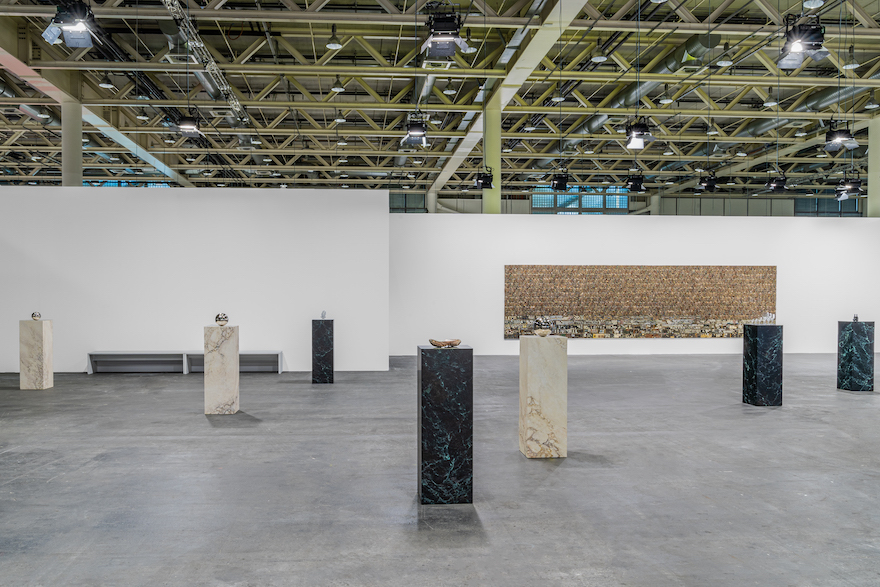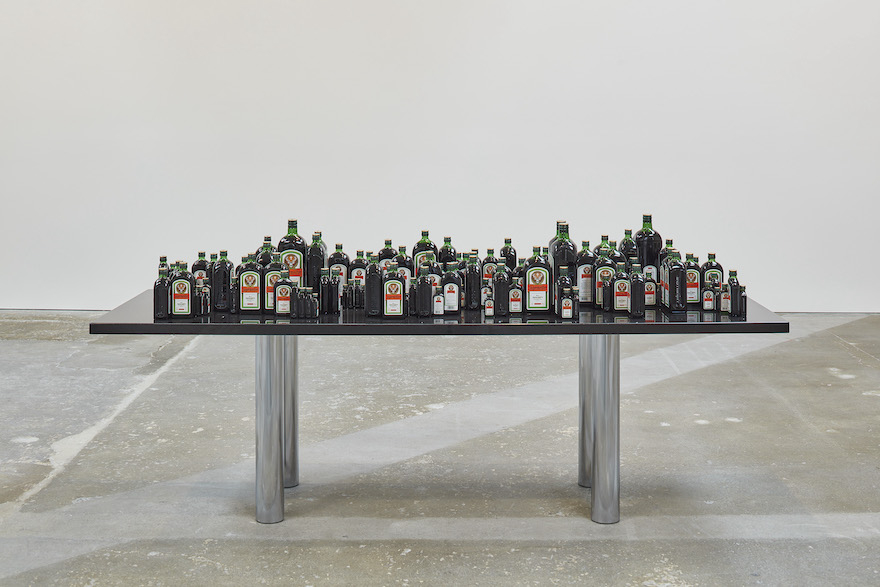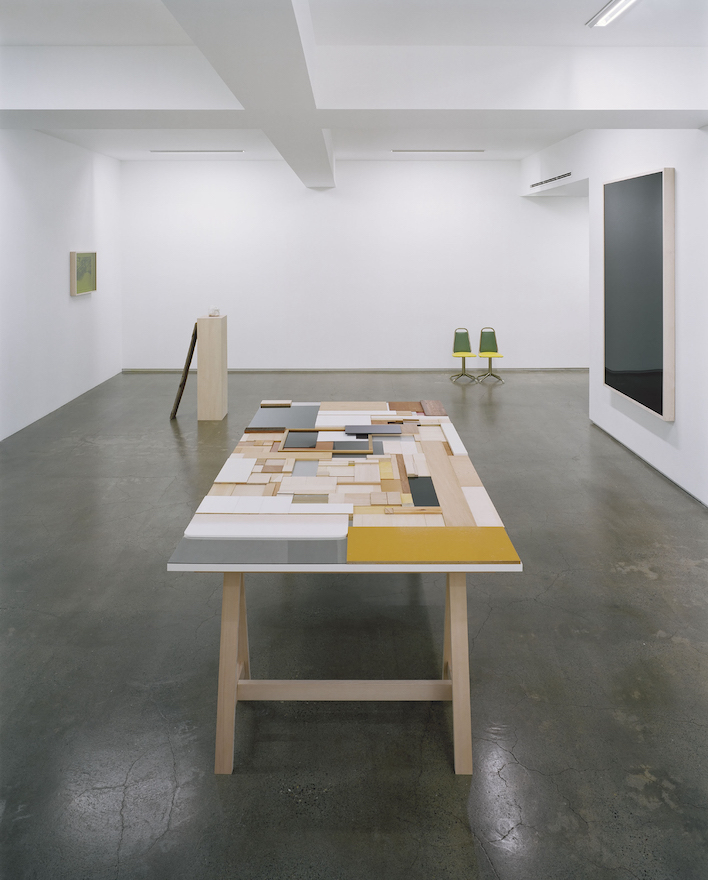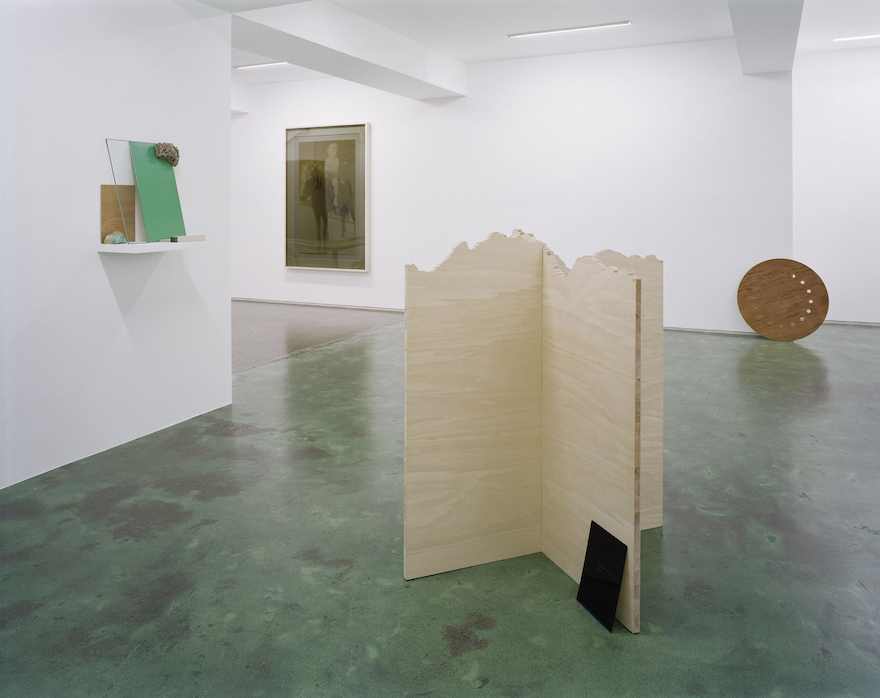Kimura Yuki was selected to show this year at
Unlimited 2023, Art Basel. For the massive venue she recreated the site-specific installation
COL SPORCAR SI TROVA, which was presented last year at the
Kunstverein Dusseldorf (May 14–August 21, 2022, curated by Kathrin Bentele), a completely different venue. Spaced out around the Basel venue, an expansive open area as opposed to a standard white cube-style solo exhibition space, are eleven rectangular pedestals meticulously decorated with trompe l’oeil renderings of black and white marble textures, on each of which sit similarly shaped but different sized readymade objects (extra-small, small, medium, large and extra-large mirror balls; abalone shells, a set of gin bottles of various sizes, wine glasses, glass plates, rubber penholders). In stark contrast to the surrounding “socially engaged” works, whose contents are communicated through extremely generous explanatory texts and whose massive scale matching that of the venue might also please visitors more, Kimura’s installation has a dignified appearance. Consisting solely of mysterious readymade objects scattered solemnly about the venue with no explanation whatsoever, it not only reminds us that “this is what art was originally meant to be,” but also highlights how by pandering to audiences’ understanding and empathy, “socially engaged art” and “relational art” have degenerated into ostentatious production and are nearing their end. It is not that Kimura’s work is not “social.” It is simply that “art” to which labels such as “socially engaged” or “social relations” are assigned from the outset by way of explanations, and in which viewers simply learn like students in a classroom (and consume spectacular production), is not worthy of the name “art.”

Yuki Kimura, COL SPORCAR SI TROVA, installation view at Unlimited, Art Basel, Jun 15–18, 2023.
Courtesy of Galerie Chantal Crousel and Taka Ishii Gallery / Photo: Jiayun Deng
follows on from
Table Matematica (2016), which was presented by
Taka Ishii Gallery at Art Basel in 2017. This was an extremely carefree work consisting solely of German liqueur bottles, which are sold in various sizes, arranged on top of a table. The not inconsiderable number of viewers who visited the booth and encountered it were at once somewhat surprised at the variations in size of the same bottle and found it difficult to leave as various questions occurred to them. It was apparently as a result of presenting this work that the artist met the curator Kathrin Bentele, in which sense one could say that Europe has a properly-functioning critical sensibility that does not appreciate sociological reports presenting “research” on “local = global” issues, or long-winded “documentaries” that take up people’s time.


On top of a black table, bottles of Jagermeister (a traditional German liqueur) of various sizes ranging from the smallest to largest stand side by side. There is also an unsavory image of the consequence of the endless deliciousness of drinking the 35-proof liqueur followed by beer chasers being alcoholism.
Yuki Kimura, Table Matematica, 2016, granite, chrome plated legs, Jägermeister bottles, 105.7 x 80 x 240 cm
Courtesy of CCA Wattis Institute for Contemporary Arts and Taka Ishii Gallery / Photos: Johnna Arnold
Before heading to Europe, Kimura was known for her installations based on found photos (including “found” snaps she had taken herself). These were spatial developments of memories associated with images in which spaces became echo chambers where various images or objects that resonated with a particular photo or photos were spread out. In this case, however, “memories” are not nostalgic reminiscences. Take for example all the data stored on a hard drive over a ten year period while switching computers. One might have completely forgotten what one saved over those ten years, but after doing a full-text search for “Richter,” results including parts of texts, some remembered some not, emails concerning “Richter,” people’s names and images and even “Be
richterstattung” might appear, forming a kind of network. If instead of searching for “Richter” on a hard drive we could search the memories lurking inside our brains for particular images (“alps,” for example), then Kimura’s installations could be compared to the network that might surface there.
However, the problem is that whereas “Richter” is always the character string “Richter,” photos of alps are not necessarily always remembered as “alps” inside the brain. We cannot know in advance how photos will be remembered. At the least there are three levels: the subject level (what is in the photo), the material level (the texture of the photographic paper, frayed edges, sepia tones), and the information level (the history of the shooting location, etc.). Moreover, these are remembered in a clouded state. As someone who develops memories of images, Kimura’s method involves listening for, extracting and reconstructing individual memory elements by applying particular “tuning forks” (works), as it were, to this clouded state and making them resonate. It is after this resonation that memories surface. In other words, memories of images are not a return to the past. The reality of the memories probably differs completely depending on the “tuning forks” used.


Yuki Kimura, Year 1940 was a leap year starting on Monday, installation views at Taka Ishii Gallery, Oct 10–Nov 7, 2009.
Courtesy of Taka Ishii Gallery / Photos: Yasushi Ichikawa
This reconstruction of memory elements is none other than collage. Digital photo collaging is not combining photos at will using digital technology. It is regarding a single photo as a collage of various clouded elements. Looking back, in the 2009 solo exhibition
“Year 1940 was a leap year starting on Monday” (Taka Ishii Gallery, October 10–November 7, 2009), there were object collages that traversed memory elements without using photos at all. In this group of works, which zeroed in on “memories” of images most extremely precisely because they abandoned recreation, one can see precursors of
Table Matematica.
(To be continued)
—————————————————————-
Shimizu Minoru
Critic. Professor, Doshisha University.





